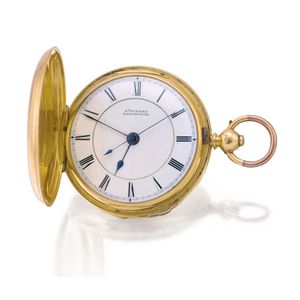William Picken 18ct Gold Pulse Watch
You must be a subscriber, and be logged in to view price and dealer details.
Subscribe Now to view actual auction price for this item
When you subscribe, you have the option of setting the currency in which to display prices to $Au, $US, $NZ or Stg.
- Movement - The technical name for the workings of a clock or watch, and does not include the dial or case.
- Circa - A Latin term meaning 'about', often used in the antique trade to give an approximate date for the piece, usually considered to be five years on either side of the circa year. Thus, circa 1900 means the piece was made about 1900, probably between 1895 and 1905. The expression is sometimes abbreviated to c.1900.
- Fusee - The fusee movement was used in clocks and pocket watches from the mid 17th century. The fusee is a cone shaped drum within the works that is linked to the barrel of the spring, usually by a length of chain.
As the mainspring loses its tension over time, the cone shaped barrel compensates for this by increasing the tension, by pulling the mainspring tighter, thus ensuring the time remains constant.
Use of the fusee in clocks was superseded by the "going barrel" in the mid 19th century and for pocket watches at the beginning of the 19th century.
The fusee continued to be used in marine chronometers until the 1970s.
This item has been included into following indexes:
- pocket watches, case type
Visually similar items

A. Lange & Sohne a 14ct gold keyless lever hunting cased pocket watch no 85649 circa 1910, frosted gilt 3/4 plate lever movement signed Deutsche Uhrenfabrikation Glashutte cut and compensated bi-metallic balance, white enamel dial with black Arabic numeral

A Swiss gold plated Hour Repeat pocket watch, c.1910, hunter case with lever movement. Enamel dial in good condition. Diameter 57 mm.

A good Swiss 'Baume' gold hunter repeating pocket watch, hallmarked and stamped 18ct gold case. Chronograph quarter repeating movement with subsidiary seconds and minutes dials. Jewelled to the centre (needs adjusting). Diameter 53 mm, TW 141gms.

A Swiss gold hunter pocket watch, c.1910, stamped 14ct gold with hallmarks. 3/4 plate movement for John Elkan, London. Centre seconds hand. Diameter 52 mm.
